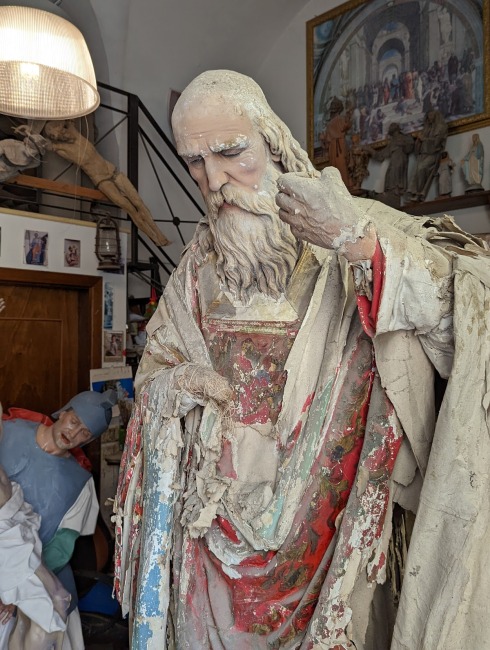
Cartapesta means papier mache (chewed up paper.) Before we entered the studios of Lecce’s papier mache artists my understanding of the art was limited to masks, pinatas and the giant puppet heads we saw at Bread and Puppet theater in Vermont and in the central plaza of San Miguel Allende in Mexico. The papier mache tradition unique to Puglia raises the genre to the level of fine art.

The craftsmen of Lecce discovered that the art of “plasticising” paper allowing them to create sacred works to help summon the faithful back to worship when the Counter-Reformation Church was engaged in its crusade against the Lutheran heresy.
Barbers were the first papier mache artists with their workshops in the back of their barber shops. The craftsmen did not have access to precious materials, so they were forced to make use of poorer resources such as straw, rags, glue and plaster.
Creation of papier mache figures requires many painstaking processes depending on the scenes being created. It begins by building a wire structure which works as a skeleton and covering the structure with curly straw and hemp to define the body of the figure. The straw is then covered with the papier mache mixture which will be shaped into the final figure.


The processing of papier mache is a very ancient art and it is strongly anchored to the city of Lecce and Baroque architecture, which had maximum artistic expression during the seventeenth and eighteenth centuries. The papier mache is made of paper, water and glue but its versatility can reproduce more noble materials such as silver, marble or bronze. In the churches of Lecce papier mache can be found from walls, ceilings and pillars, to the decorative figures of saints and putti.


Papier-mache artists, like the stone carvers of Northern Italy who created myriad illusions with stone, the artists of Salento created realistic figures with straw, rags, glue and plaster.





Some papier mache artists work on a larger and some on a smaller scale. Claudio Riso and his brothers, Giuseppe and Sandro follow the strict traditions of Salento in creation of their papier mache figures and scenes. The process of creation requires up to twenty-five different phases.

Claudio Riso creates the underlying wire structure and builds that out with curly straw. He covers the straw with papier mache then adds hands and feet of terracotta.

Giuseppe is the tailor of the group making papier mache clothes creating folds and modeling to give the figures movement and a realistic affect.

Sandro adds the coloring including the intricate details of the face and especially the eyes to create the soul of the statue.



The work of the brothers is intricate and detailed, some including complete scenes of Italian country life.

Cartapesta has been called “the poor man’s marble.” Though it may have begun as a substitute for the more expensive carved marble of Northern Italian churches, it has grown into its own art form centered in Lecce. Whether a light as a feather basket of lemons that fits in the palm of your hand, a larger than life-size statue of the crucifixion or the curls and swirls, catouches and swags of a Baroque church interior, cartapesta is its own original art tradition.

wow that’s so interesting! loving hearing about all your adventures, thank you!
Charming craft. At a time in our history where we just don’t make stuff the way we used to. To our detriment.
When we visited Claudio Riso’s workshop, Claudio was working all by himself in the back. It was so quiet and he was so clearly in his own place of creation. So wonderful that he and his brothers work together carrying on a tradition that is unique to their “home.” Italians have a wonderful capacity to live their lives more seemlessly than other cultures. The boundaries between work and home go back and forth throughout the day with short stops for a shot of coffee or a tiramezzini (little sandwich) while moving between. This is also time to stop and talk in the street with a neighbor. This, accompanied with balletic hand gentures.
That is so interesting! Something I’ve never heard about – a beautiful new art form!
I just returned from a much colder place, and I thought some of your followers might want to see my YouTube video of my trip…here’s the link to it! Hope you don’t mind…
@ LINK TO ANTARCTICA 2022 V2: https://youtu.be/DY58PytJ5ZY
Remarkable! The detail achieved is amazing, and the finishes!! Wow. I always learn something from your posts. (The hand photo is especially beautiful. Kudos to Dana on all).
Thank you Dede.
Like so much that is wonder-full in the world, I had no idea. Thanks for expanding my horizon as you explore new ones.
I never imagined papier mache could look like metal until I saw it here.
Interesting to find out the origin of papier mache as well as how many people are involved to make such beautiful fine art. A far cry from the blown-up balloon that we used as the basis to make a paper mache piñata. BTW…what is done with the artwork? Is it sold to tourists? Churches? Personal collections?, etc. Was there a shop where you could buy a piece? Did the shop offer a tour or did you go on your own?
For the most part the artwork, especially religious artwork, is done on commission. But the workshops have an area where pieces that are for sale are displayed. We went on our own though workshops offer classes in papier mache. The Baroque churches of Lecce are filled with papier mache saints and many homes have religious art. It is interesting that we have not seen anything that looks as if it is created solely for tourists.